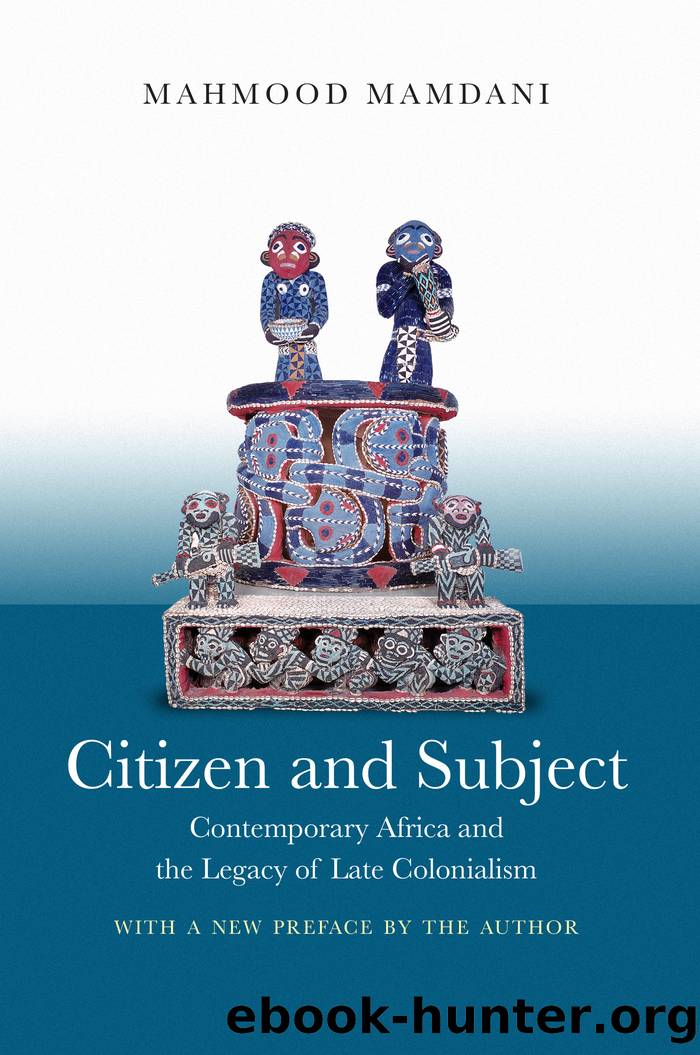Citizen and Subject by Mahmood Mamdani

Author:Mahmood Mamdani
Language: eng
Format: epub
Publisher: Princeton University Press
Published: 2018-05-15T00:00:00+00:00
Part Two
THE ANATOMY OF RESISTANCE
CHAPTER SIX
The Other Face of Tribalism: Peasant Movements in Equatorial Africa
I HAVE ARGUED that there was a real internal difference between civil power over citizens and customary power over free peasants. That difference turned more on the political than on the economic. It was not a difference between capitalist and precapitalist or market and premarket formations. The free peasantry lives neither outside market relations nor simply within it. It lives, rather, on the interstices of the market and direct compulsions. The internal difference between civil society and the free peasantry, however, lay in the mode of rule characteristic of each: whereas civil society was governed directly by a civil power enforcing a civil law claiming to guarantee rights, the free peasantry was ruled indirectly through Native Authorities whose claim was to enforce custom through a customary law.
The claim to legitimacy of customary law was that it was tribal law, and of customary authorities that they were the tribal authorities administering tribal law. Tribalism then was the very form that colonial rule took within the local state. At the same time, the revolt against indirect rule also took a tribal form. For a revolt aimed against indirect rule authority was inevitably confined to its parameters. A democratic struggle against the authorities of the local state had to take the form of a civil war within the tribe, and so it did everywhere. The customary form of the local state made for a simultaneous reproduction of ethnic identities in the tribally based system of decentralized despotism and for their blowing up from within. My point is that modern tribalism has to be understood not only as a historical phenomenon, but also as one that is contradictory. It signifies both the form of rule and the form of revolt against it. Whereas the former is oppressive, the latter may be emancipatory.
An internal civil war, however, cannot exhaustively explain the phenomenon usually referred to as tribalism, for we all know that media references to tribalism accent more the interethnic than the intraethnic, the conflict between tribes and not that within a tribe. My point is not to deny the existence of the former, but to claim that the nature of conflict between ethnic groups in the larger polity is difficult to grasp unless we relate it to the conflict within a tribe. Without that connection, we will be left with no more than a tautology: different tribes fight because they are different.
Two clues can help us break out of this tautology and make that connection. Both are social effects of the customary. We saw in the last chapter how state enforcement tended to rob custom of its diversity, homogenize it, and equate it with the boundaries of the tribe. The other side of this flattening tendency was to poseâsharper than ever beforeâthe problem of the ethnic stranger, for customary tenure effects a division between the peasant in the customary home and the migrant (stranger) peasant; the same customary right that underlines the security of the formerâs holding renders the latter insecure on borrowed land.
Download
This site does not store any files on its server. We only index and link to content provided by other sites. Please contact the content providers to delete copyright contents if any and email us, we'll remove relevant links or contents immediately.
The Secret History by Donna Tartt(16762)
The Social Justice Warrior Handbook by Lisa De Pasquale(11517)
Thirteen Reasons Why by Jay Asher(7856)
This Is How You Lose Her by Junot Diaz(5845)
Weapons of Math Destruction by Cathy O'Neil(5094)
Zero to One by Peter Thiel(4885)
The Myth of the Strong Leader by Archie Brown(4821)
Promise Me, Dad by Joe Biden(4493)
Beartown by Fredrik Backman(4489)
How Democracies Die by Steven Levitsky & Daniel Ziblatt(4465)
Stone's Rules by Roger Stone(4455)
The Fire Next Time by James Baldwin(4398)
100 Deadly Skills by Clint Emerson(4128)
A Higher Loyalty: Truth, Lies, and Leadership by James Comey(4073)
Rise and Kill First by Ronen Bergman(4062)
The David Icke Guide to the Global Conspiracy (and how to end it) by David Icke(3934)
The Farm by Tom Rob Smith(3908)
Secrecy World by Jake Bernstein(3828)
The Doomsday Machine by Daniel Ellsberg(3772)
